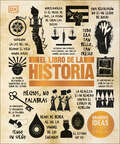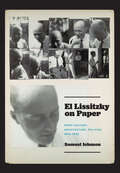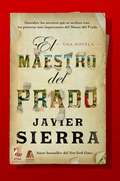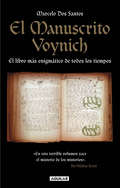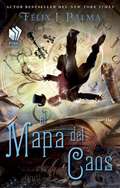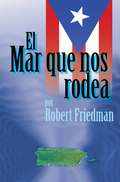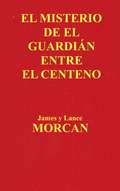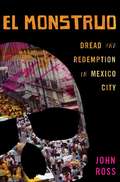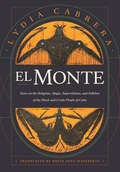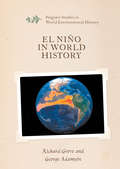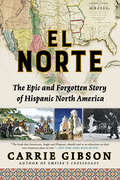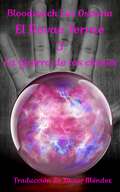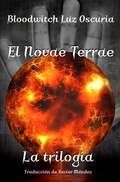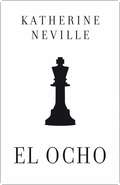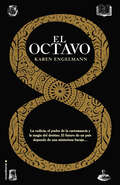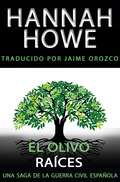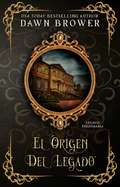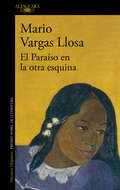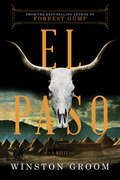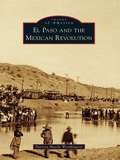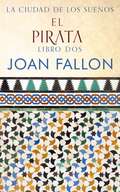- Table View
- List View
El Libro de la historia (DK Big Ideas)
by DK¿Qué permitió el surgimiento de la democracia en la antigua Grecia? ¿Cómo conquistó España América Central y del Sur? ¿Qué provocó la caída del Muro de Berlín? Este libro responde a estas y otras muchas cuestiones revisando las civilizaciones, las revoluciones y los avances tecnológicos que han hecho nuestro mundo irreconocible para nuestros ancestros. Con un lenguaje claro, El libro de la historia ofrece breves y sencillas explicaciones de las ideas que subyacen a los eventos que han configurado nuestro mundo, esquemas que simplifican conceptos complejos e ingeniosas ilustraciones que juegan con nuestras ideas sobre el pasado. Tanto el nuevo en la materia, como el ávido estudiante o el apasionado de la historia, hallarán en este libro mucha información interesante.
El Lissitzky on Paper: Print Culture, Architecture, Politics, 1919–1933
by Samuel JohnsonAn examination of the importance of paper in the work of Soviet artist, designer, and architect El Lissitzky. Russian artist El Lissitzky’s work spans painting, photography, theatrical and exhibition design, architecture, graphic design, typography, and literature. He was active in the Jewish cultural renaissance, formed an artists’ collective with Kazimir Malevich, was a key figure in the dissemination of early Soviet art in Western Europe, and designed propaganda for the Stalin regime. With such a varied history and body of work, scholars have often struggled to identify the core principles that tied his diverse oeuvre together. In El Lissitzky on Paper, Samuel Johnson argues that Lissitzky’s commitment to creating works on paper is a constant that unites his endeavors. Paper played a key role in the utopian projects that informed Lissitzky’s work, and the artist held a commitment to print as the premier medium of immediate public exchange. Johnson analyzes and contextualizes this idea against the USSR’s strict management of this essential resource and the growth of new media communications, including the telephone, telegraph, and film. With this book, Johnson presents a significant contribution to scholarship on this major artist, revealing new connections between Lissitzky’s work in architecture and visual art and bringing to light sources from largely unstudied Russian archives.
El Maestro de Grex
by Joan WolfCuando Daniel Dereham hace su primera aparición en Londres, no pasa mucho tiempo antes de que las lenguas aristocráticas inglesas se muevan de curiosidad. ¿Quién es este hombre misterioso rico y hermoso? Lady Anne Sexton necesita un marido adinerado que conserve la propiedad de Grex y la devuelva a su antigua gloria. Si casarse con Dereham le permite quedarse en su casa, entonces hará lo que tenga que hacer. ¿Es un acuerdo comercial... o potencialmente el comienzo de algo más?
El Maestro del Prado (The Master of the Prado)
by Javier SierraUn libro asombroso. Sólo así puede definirse lo que el autor de La cena secreta confía ahora a sus lectores. Esta aventura se inicia en 1990, cuando Javier Sierra tropieza en las galerías del Museo del Prado con un misterioso personaje que se ofrece a explicarle las claves ocultas de algunas de sus obras maestras. Visiones místicas, anuncios proféticos, conspiraciones, herejías y hasta mensajes que parecen llegados del otro lado inspiraron a maestros como Rafael, Tiziano, el Bosco, Juan de Juanes, Botticelli, Brueghel o el Greco. Y según ese inesperado maestro, lo que todos ellos dejaron escrito en sus pinturas es tan sobrecogedor como revolucionario. Léalo como la mejor de las novelas mientras descubre un lado de la cultura pictórica europea que ni imaginaba.
El Manuscrito Voynich: El libro más enigmático de todos los tiempos (Ensayo Historico Ser.)
by Marcelo Dos SantosUn largo, apasionante y sorprendente periplo histórico que se remonta hasta la Edad Media, nos devela los extraordinarios personajes que se vieron involucrados con este manuscrito medieval. «En este terrible volumen yace el misterio de los misterios.»Sir Walter Scott El Manuscrito Voynich representa el mayor y más desconcertante acertijo literario de la historia. Se trata del único manuscrito medieval no descifrado que queda en el planeta. Está escrito en un código incomprensible, cuya clave no ha podido ser descubierta ni siquiera por los criptógrafos militares que rompieron los códigos alemanes y japoneses en la Segunda Guerra Mundial. Sus páginas están cubiertas de ilustraciones de mujeres desnudas, plantas inexistentes y constelaciones desconocidas para la astronomía. Analizado ya en el Renacimiento, el extraño libro cifrado desapareció durante siglos hasta ser redescubierto a principios del siglo XX. Se han aplicado con él todas las técnicas posibles a fin de arrancarle sus secretos, pero el Manuscrito Voynich aparenta ser inmune a los esfuerzos de los estudiosos.
El Mapa del caos: novela (Atria Espanol)
by Félix J. PalmaFrom the New York Times bestselling author of The Map of Time and The Map of the Sky, the final installment in the award-winning trilogy that The Washington Post called “a big, genre-bending delight.”
El Mar Que Nos Rodea
by Maria Emilia Ruiz Robert FriedmanTranscurre el año 2000 en Puerto Rico. Stevie Pérez y su novia Laura Rosario se han unido a una protesta de estudiantes contra los bombardeos de la Marina de Estados Unidos que han causado enfermedades, daños ambientales y muertes en la pequeña isla de Vieques. La brigada antidisturbios llega al campus para reprimir la protesta y con la consiguiente violencia, Laura recibe un disparo de bala y muere.Un afligido Stevie promete mantener la memoria de Laura viva, creando una beca con su nombre. Sus intentos de conseguir fondos de la comunidad se ven frustrados y decide convertirse en una mula de drogas para conseguir el dinero para la beca. Luego de varios viajes lucrativos, queda en medio de una trampa. Su vida queda en peligro, y Stevie se ve forzado a escapar de la pandilla que lo persigue de el Bronx hasta San Juan y al pueblo en las montañas de Puerto Rico. En el camino, Stevie aprende duras verdades sobre la vida, el amor y las pérdidas.
El Misterio de el Guardián Entre el Centeno
by James Morcan Lance Morcan Pedro Rafael Gómez BarrosoEl Misterio de El guardián entre el centeno, de James Morcan y Lance Morcan Descubriendo los misterios que rodean al clásico de J.D. Salinger. “El Misterio de El guardián entre el Centeno saca a la luz los misterios de la famosa novela de 1951 “El guardián entre el Centeno”, de J.D. Salinger – probablemente la novela más controvertida de todos los tiempos. Conocida para muchos por representar la máxima expresión de la ansiedad en la adolescencia, esta novela ha sido catalogada como inmoral por distintos grupos sociales. De hecho, a lo largo de las décadas se ha prohibido su difusión en algunos estados norteamericanos. No obstante, el principal motivo que incentivó la prohibición de esta novela fue la implicación directa o la asociación del libro con algunos de los asesinatos más infames y crueles acaecidos en el siglo XX. Entre estos crímenes se incluyen el asesinato de John Lennon y el intento de asesinato del Presidente Reagan. De este modo, se acusa a Salinger (y/o la editorial) de ingeniárselas astutamente para llenar su libro de pasajes neurolingüísticos, o mensajes ocultos, que actúan como sugestión post-hipnótica o controlan la mente. Y así, todos estos mensajes posibilitaron a los agentes de la CIA la creación de “Candidatos Manchúes”, es decir, asesinos controlados mentalmente por el Gobierno. Muchos son los que piensan que la novela formó parte del amplio programa de control mental de la CIA, ya desclasificado en su mayoría, conocido como MK-Ultra, y que mientras los asesinos eran sometidos a un lavado de cerebro, también eran obligados a leer y releer la historia hasta que calase en sus mentes. Los Morcans investigan estas teorías con sus argumentos en "El Misterio de El guardián entre el centeno" – el cuarto libro de The Underground Knowledge Series. Esta equilibrada explicación finalmente le deja a usted, el lector, la decisión de si la novela de J.D. Salinger
El Monstruo: Dread and Redemption in Mexico City
by John RossJohn Ross has been living in the old colonial quarter of Mexico City for the last three decades, a rebel journalist covering Mexico and the region from the bottom up. He is filled with a gnawing sense that his beloved Mexico City’s days as the most gargantuan, chaotic, crime-ridden, toxically contaminated urban stain in the western world are doomed, and the monster he has grown to know and love through a quarter century of reporting on its foibles and tragedies and blight will be globalized into one more McCity. El Monstruois a defense of place and the history of that place. No one has told the gritty, vibrant histories of this city of 23 million faceless souls from the ground up, listened to the stories of those who have not been crushed, deconstructed the Monstruo’s very monstrousness, and lived to tell its secrets. InEl Monstruo, Ross now does.
El Monte: Notes on the Religions, Magic, and Folklore of the Black and Creole People of Cuba (Latin America in Translation)
by Lydia CabreraFirst published in Cuba in 1954 and appearing here in English for the first time, Lydia Cabrera’s El Monte is a foundational and iconic study of Afro-Cuban religious and cultural traditions. Drawing on conversations with elderly Afro-Cuban priests who were one or two generations away from the transatlantic slave trade, Cabrera combines ethnography, history, folklore, literature, and botany to provide a panoramic account of the multifaceted influence of Afro-Atlantic cultures in Cuba. Cabrera details the natural and spiritual landscape of the Cuban monte (forest, wilderness) and discusses hundreds of herbs and the constellations of deities, sacred rites, and knowledge that envelop them. The result is a complex spiritual and medicinal architecture of Afro-Cuban cultures. This new edition of what is often referred to as “the Santería bible” includes a new foreword, introduction, and translator notes. As a seminal work in the study of the African diaspora that has profoundly impacted numerous fields, Cabrera’s magnum opus is essential for scholars, activists, and religious devotees of Afro-Cuban traditions alike.
El Niño in World History (Palgrave Studies in World Environmental History)
by George Adamson Richard GroveThis book examines the role of the El Niño Southern Oscillation (ENSO) in society. Throughout human history, large or recurrent El Niños could cause significant disruption to societies and in some cases even contribute to political change. Yet it is only now that we are coming to appreciate the significance of the phenomenon. In this volume, Richard Grove and George Adamson chart the dual history of El Niño: as a global phenomenon capable of devastating weather extremes and, since the 18th century, as a developing idea in science and society. The chapters trace El Niño’s position in world history from its role in the revolution in Australian Aboriginal Culture at 5,000 BP to the 2015-16 ‘Godzilla’ event. It ends with a discussion of El Niño in the current media, which is as much a product of the public imagination as it is a natural process.
El Nombre del Amor
by Helen Susan SwiftEn su cumpleaños número 20, Mary Hepburn - hija de un magistrado local - se entera que se casará con John Aitken, un hombre mucho mayor que ella. Sintiéndose infeliz con esto, Mary camina por el páramo local para aclarar su mente. En cambio, conoce y se enamora del guapo Capitán Ferintosh, cuando él la salva de unos contrabandistas de whisky. La situación se complica aún más cuando el padre de Mary arresta a Ferintosh Pronto, planes retorcidos y misterios salen a la luz. Pero ¿quién es digno de su amor, y qué secretos esconden los hombres que la rodean?
El Norte: The Epic and Forgotten Story of Hispanic North America
by Carrie GibsonA sweeping saga of the Spanish history and influence in North America over five centuries, from the acclaimed author of Empire’s Crossroads.Because of our shared English language, as well as the celebrated origin tales of the Mayflower and the rebellion of the British colonies, the United States has prized its Anglo heritage above all others. However, as Carrie Gibson explains with great depth and clarity in El Norte, the nation has much older Spanish roots?ones that have long been unacknowledged or marginalized. The Hispanic past of the United States predates the arrival of the Pilgrims by a century, and has been every bit as important in shaping the nation as it exists today.El Norte chronicles the dramatic history of Hispanic North America from the arrival of the Spanish in the early 16th century to the present?from Ponce de Leon’s initial landing in Florida in 1513 to Spanish control of the vast Louisiana territory in 1762 to the Mexican-American War in 1846 and up to the more recent tragedy of post-hurricane Puerto Rico and the ongoing border acrimony with Mexico. Interwoven in this narrative of events and people are cultural issues that have been there from the start but which are unresolved to this day: language, belonging, community, race, and nationality. Seeing them play out over centuries provides vital perspective at a time when it is urgently needed.In 1883, Walt Whitman meditated on his country’s Spanish past: “We Americans have yet to really learn our own antecedents, and sort them, to unify them,” predicting that “to that composite American identity of the future, Spanish character will supply some of the most needed parts.” That future is here, and El Norte, a stirring and eventful history in its own right, will make a powerful impact on our national understanding.“This history debunks the myth of American exceptionalism by revisiting a past that is not British and Protestant but Hispanic and Catholic. Gibson begins with the arrival of Spaniards in La Florida, in 1513, discusses Mexico’s ceding of territory to the U.S., in 1848, and concludes with Trump’s nativist fixations. Along the way, she explains how California came to be named after a fictional island in a book by a Castilian Renaissance writer and asks why we ignore a chapter of our history that began long before the Pilgrims arrived. At a time when the building of walls occupies so much attention, Gibson makes a case for the blurring of boundaries.” —New Yorker“A sweeping and accessible survey of the Hispanic history of the U.S. that illuminates the integral impact of the Spanish and their descendants on the U.S.’s social and cultural development. . . . This unusual and insightful work provides a welcome and thought-provoking angle on the country’s history, and should be widely appreciated.” —Publishers Weekly, starred review, PW Pick
El Novae Terrae 1: La guerra de la sangre (El Novae Terrae #1)
by Bloodwitch Luz OscuriaImagínate un mundo en el que nada es en realidad lo que te habías imaginado hasta ahora. Descubre, desde los orígenes del mundo hasta nuestros días, la parte oculta que no podías ver. Partamos de viaje por toda la tierra al lado de una Vampira enigmática, y descubramos junto a ella los secretos que la historia tenía enterrados, secretos que ningún libro ha contado hasta ahora, y que Tomasz conocerá al mismo tiempo que tú. Porque el mundo tal y como lo conocías no es más que la cara de los secretos de la humanidad ocultados por una increíble Maga con poderes tan vastos como sorprendentes
El Novae Terrae 2: La guerra del poder (El Novae Terrae #2)
by Bloodwitch Luz OscuriaAhora ya sabemos que la intervención de la Maga ha tenido como efecto un gran cambio en el orden de las cosas del mundo terrenal, sobre todo para nosotros, los seres humanos. El Cazador de Vampiros de la Orden de los Eternos se encuentra ahora en apuros, y los Eternos no pueden ayudarlo, pues desconocen su situación. El futuro parece ir en favor de los vampiros ahora. Pero habrá que contar con la intervención de varios protagonistas que nadie se esperaba, y que contribuirán a modificar el porvenir del mundo a su favor. ¿Podrá cambiar el destino al que está ligado el planeta?
El Novae Terrae 3 - La guerra de los clanes (El Novae Terrae #3)
by Bloodwitch Luz OscuriaEl Cazador de Vampiros de la Orden de los Eternos se ha esfumado, así como también todos aquellos con los que intentó proteger el "Novae Terrae" frente a una horda de vampiros dirigidos por Eleonor y Aleksis, quienes asaltaron la fortaleza en la que se guarecían Tomasz, Mylena y los Eternos. Sin embargo, no está todo perdido, queda una esperanza en la persona de Sarah, quien proviene de un Cazador y de una Maga. Es un ser excepcional que promete muchas y variadas sorpresas para los vampiros. Los dos clanes esta vez estarán rodeados por nuevos aliados, y el desenlace de esta historia no está nada seguro.
El Novae Terrae, La trilogía (El Novae Terrae #4)
by Bloodwitch Luz OscuriaEn los albores, el nacimiento de Luisú Sazanús, una criatura surgida del primer vampiro de la historia, estaba a punto de sumir el mundo entero en el caos. Esa amenaza movió a su madre, de naturaleza humana pero también una de las más poderosas magas que jamás hubiera habido sobre la faz de la tierra, a crear una reliquia en la que encerró el poder más insigne de todos, para evitar que su descendiente no lo usara contra la humanidad. Asimismo, fundó la Orden de los Eternos para velar por la seguridad de aquel objeto tan codiciado. Estos decidieron confiárselo a un ser único, un Cazador, quien también tendría que luchar contra los descendientes de Luisú, dispuestos a lograr sus objetivos. Pero planeaba otra amenaza: Eleonor, una criatura que no era de las que se rendían fácilmente...
El Octavo
by Karen EngelmannLa codicia, el poder de la cartomancia y la magia del destino. El futuro de un país depende de una misteriosa baraja. Una brillante novela histórica desarrollada en el Estocolmo del siglo XVIII. Estocolmo, 1789. El reinado de Gustavo III se tambalea. Emil Larsson, un joven oficial de aduanas, vividor, bebedor y jugador, visita regularmente el exclusivo Salón de Sofía Sparrow, mujer influyente de la sociedad de la capital sueca.La señora Sparrow ve grandes cosas para el futuro de Emil cuando decide echarle las cartas del Octavo, un poderoso tipo de cartomancia que puede ayudar al joven a solucionar su futuro si consigue averiguar quiénes son las ocho personas que se esconden tras cada unos de los naipes. Sin embargo, Emil y Sofía pronto se darán cuenta de que tras las cartas se esconde mucho más que la felicidad del joven o su fortuna: en medio de la revolución y el caos que pueden derrocar al rey Gustavo, no se puede estar seguro de quién es amigo y quién enemigo...
El Olivo; Raíces: Una Saga de la Guerra Civil Española (El Olivo #1)
by Hannah HoweEnmarcado en el periodo de tiempo de abril de 1937 a Diciembre de 1938, El Olivo es una colección de mini-series de cinco novelas basadas en hechos reales. Las historias de El Olivo – Raíces, Ramas, Hojas, Fruto y Flores – narran la vida de Heini Hopkins, una enfermera joven de una empobrecida parte de Gales del Sur, y Naomi Parker, una autora rica de un privilegiado estrato social. En Raíces, Heini está en casa cuidando de su madre enferma en Gales, mientras Naomi asiste a presentaciones de su más reciente novela. La guerra civil en España parece un mundo aparte, hasta que los fascistas bombardean y destruyen Guernica, acabando con la vida de miles de hombres, mujeres y niños. El novio de Heini; Deiniol Price, es un hombre que trabaja en una mina de carbón que tiene la mirada puesta en ayudar a la causa de la Republica Española, buscando colaborar como voluntario en Brigadas Internacionales, mientras que el amante de Naomi; el conde Nicolas Esteban, es un piloto que sueña con la gloria de luchar junto los fascistas. ¿Qué destino les aguarda a Heini y Naomi si deciden seguir a sus hombres dejando la seguridad de Gales para adentrarse en los sangrientos campos de batalla en España?
El Origen Del Legado
by Dawn Brower¿Qué hace que una persona sea una bruja? Para aquellos que viven en la Escocia del siglo XVI, la palabra bruja es aterradora. Todos tienen miedo de las brujas, tanto de ser acusados ??de uno como de ser maldecidos por uno. En una serie de eventos más allá de su control, una familia enfrenta su miedo final y las consecuencias de las que no pueden escapar. La idea misma de la brujería se vuelve demasiado real para la familia Dalais. Caitríona Dalais Guaire, Sorcha Dalais Creag y Niall Dalais son arrancados de sus hogares y procesados. Sus vidas están en juego, y todo apunta a su eventual desaparición. En un acto de desesperación, uno de ellos hace que los niños sean guardados en un lugar seguro. Solo el tiempo dirá si tienen éxito y si su legado vivirá ... Género: FICCIÓN / Idioma Original: inglés Idioma Traducido: Español
El Paraíso en la otra esquina
by Mario Vargas LlosaUn nexo de unión entre dos personajes que optan por dos modelos vitales opuestos que desvelan un deseo común: el de alcanzar un paraíso donde sea posible la felicidad para los seres humanos. Dos vidas: la de Flora Tristán, que pone todos sus esfuerzos en la lucha por los derechos de la mujer y de los obreros, y la de Paul Gauguin, el hombre que descubre su pasión por la pintura y abandona su existencia burguesa para viajar a Tahití en busca de un mundo sin contaminar por las convenciones. Dos concepciones del sexo: la de Flora, que solo ve en él un instrumento de dominio masculino y la de Gauguin, que lo considera una fuerza vital imprescindible puesta al servicio de su creatividad. ¿Qué tienen en común esas dos vidas desligadas y opuestas, aparte del vínculo familiar por ser Flora la abuela materna de Gauguin? Esto es lo que Vargas Llosa pone de relieve en El Paraíso en la otra esquina (2003): el mundo de utopías que fue el siglo XIX. La crítica ha dicho...«Dada la maestría de Vargas Llosa, el resultado no es que sea valioso, sino que resulta fascinante; no es una novela grande sino dos grandes novelas, dos narraciones históricas... Libro magistral, que son dos, como dos son los paraísos aquí evocados.»Rafael Conte, El País «La tarea de documentación e investigación que está detrás de su construcción es realmente impresionante y no menos el modo perfecto como realiza la fusión entre lo real y lo ficticio... en cuanto a las proporciones épicas que sus relatos pueden alcanzar, tal vez no haya ahora nadie en nuestra lengua que lo pueda superar.»José Miguel Oviedo, ABC Cultural «La novela de Vargas Llosa es una prueba de su capacidad para recrear imaginativamente el pasado y permitirnos extraer, como lectores, varias y aún contradictorias opciones morales.»Joaquín Marco, El Mundo
El Paso
by Winston GroomLong fascinated with the Mexican Revolution and the vicious border wars of the early twentieth century, best-selling author Winston Groom brings to life a much-forgotten period of history in this episodic saga set in six parts. Pitting the legendary Pancho Villa against "the Colonel," a thrill-seeking Bostonian railroad tycoon whose fading fortune is tied up in a colossal ranch in Chihuahua, El Paso opens during a time of dramatic upheaval in Mexico--its government being squeezed on one end by Villa's revolutionaries and on the other by "filthy" American capitalists. Content to observe the war from aboard his dazzling yacht, the Ajax, the Colonel is suddenly pulled into this drama when his famous Valle del Sol ranch is raided for nearly "two million and a half dollars in beef on the hoof. " Oblivious to the realities of war and hoping to salvage his losses, the Colonel whisks his family down to Mexico where they make a disturbing discovery: it was Villa who not only stole the cattle but also murdered their beloved ranch manager. Even worse, Villa's henchmen abduct the Colonel's grandchildren in another daring raid only days later. Frantic, the aging patriarch and his adopted son race to El Paso, hoping to gather a group of cowboys brave enough to hunt down the generalissimo on his own turf. As the desperate Yankees quickly learn once they return to Chihuahua, their deep pockets and political clout mean next to nothing in a crumbling nation rife with communist sympathizers. After weeks of searching and with no trace of Villa, the Colonel fears all is lost--that is, until a twist of fate unites his party with that of Johnny Ollas, an aspiring matador whose wife has also been kidnapped by the marauding revolutionaries. Bloodied and battered, the two factions unite, galloping off on an extraordinary manhunt through some of the most inhospitable terrain on earth: the vast and snake-ridden Sierra Madre. The novel explodes into an epic as an extraordinary cast of characters from both history and imagination begin to emerge, all vying to get their hands on the ever-elusive Villa. But no matter what prize each player ultimately seeks, no one is left unscathed in this sprawling story of heroism, injustice, and love. Replete with shootouts, daring escapes, and an unforgettable bullfight, El Paso brings to life a crucial moment in history and, in the process, becomes an indelible portrait of the American Southwest in the final days of the wild frontier.
El Paso and the Mexican Revolution (Images of America)
by Patricia Haesly WorthingtonThe Mexican Revolution took place along the entire length of the border between the United States and Mexico. Most of the intense battles and revolutionary intrigue, however, were concentrated in the border region of El Paso, Texas, and Ciudad Juárez, Mexico. For 20 years, the U.S. and Mexico border communities dealt with revolution, beginning before the 1909 Taft-Díaz visit and ending with the Escobar Revolution of 1929. In between were battles, assassinations, invasions, and attempts at diplomacy. El Paso was center stage for many of these events. Newspapers and media from all over the country flocked to the border and produced numerous stories, photographs, and colorful renditions of the Mexican Revolution. The facts and myths have been kept alive over the last 100 years, and the revolution remains an important topic of discussion today.
El Pirata (La ciudad de los sueños #2)
by Joan FallonAmbientado en la Málaga del S. XI, El Pirata es el segundo libro de la trilogía La Ciudad de los Sueños. Esta emocionante y excitante novela histórica lleva al lector a un mundo medieval de mercaderes y marinero que navegan en la costa occidental del Mediterráneo y los piratas que los aterrorizan. Temprano por la mañana el capitán pirata, al-Awar, hace una incursión relámpago en el astillero de Málaga y secuestra a Bakr, el maestro constructor naval, y dos de sus trabajadores. Antes de que nadie pueda hacer nada al respecto, han desaparecido. Nadie tiene ni idea de por qué los piratas se los han llevado o de a dónde han ido, pero todo el mundo está de acuerdo en que un solo destino les aguarda: la muerte o la esclavitud. Cuando la mujer de Bakr recibe la noticia, se queda destrozada, pero se niega a escuchar a los que dicen que hay poca esperanza de encontrar a su marido con vida. En lugar de eso está decidida a descubrir dónde se lo han llevado los piratas. Con todo el Mediterráneo para esconderse, encontrar a los hombres secuestrados parece una misión imposible, pero se niega a darse por vencida y alienta a su familia y amigos a buscarlo. En el centro de esta novela está la tierna historia de amor de Aisha y Bakr y los profundos sentimientos que se profesan. Es pensar en ella lo que le ayuda a mantenerse con vida mientras está en cautividad con pocas perspectivas de ver su casa y su familia de nuevo, y es su amor por él lo que le proporciona a ella fuerzas para no abandonar la esperanza de traerlo de nuevo a casa.
